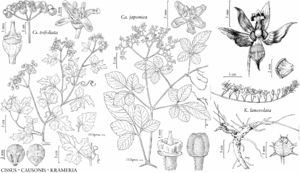Difference between revisions of "Krameria lanceolata"
Ann. Lyceum Nat. Hist. New York 2: 168. 1827.
imported>Volume Importer |
GeoffLevin (talk | contribs) m (Fixed incorrect × to x in description.) |
||
| Line 25: | Line 25: | ||
}}<!-- | }}<!-- | ||
| − | --><span class="statement" id="st-undefined" data-properties=""><b>Herbs,</b> spreading, to 2 m diam. <b>Stems</b> decumbent, long shoots only, all branches green, densely tomentose to sparsely strigose, tips soft. <b>Leaves</b>: blade linear or linear-lanceolate, 5–25 × 0.9–4 mm, | + | --><span class="statement" id="st-undefined" data-properties=""><b>Herbs,</b> spreading, to 2 m diam. <b>Stems</b> decumbent, long shoots only, all branches green, densely tomentose to sparsely strigose, tips soft. <b>Leaves</b>: blade linear or linear-lanceolate, 5–25 × 0.9–4 mm, apex acute or mucronate, surfaces strigose, lacking glandular hairs. <b>Inflorescences</b> terminal, secund racemes. <b>Flowers</b>: sepals spreading, purple, lanceolate, 8–16 mm; secretory petals pink, orange, or red, 1.5–3 mm, with oil-filled blisters on distal 1/2 of outer surfaces and distal margin; petaloid petals 5–7 mm, connate basally, distinct portions green basally, purple or pink distally, reniform, 1–3 mm; stamens equal; ovary strigose; style pink. <b>Capsules</b> circular or slightly cordate in outline, with longitudinal ridge on each face, 5–8 mm diam., hairy, spines stout, 1.8–5.3 mm, each bearing conspicuous white hairs proximally and minute, retrorse barbs near tip. <b>2n</b> = 12.</span><!-- |
-->{{Treatment/Body | -->{{Treatment/Body | ||
Latest revision as of 16:51, 29 March 2022
Herbs, spreading, to 2 m diam. Stems decumbent, long shoots only, all branches green, densely tomentose to sparsely strigose, tips soft. Leaves: blade linear or linear-lanceolate, 5–25 × 0.9–4 mm, apex acute or mucronate, surfaces strigose, lacking glandular hairs. Inflorescences terminal, secund racemes. Flowers: sepals spreading, purple, lanceolate, 8–16 mm; secretory petals pink, orange, or red, 1.5–3 mm, with oil-filled blisters on distal 1/2 of outer surfaces and distal margin; petaloid petals 5–7 mm, connate basally, distinct portions green basally, purple or pink distally, reniform, 1–3 mm; stamens equal; ovary strigose; style pink. Capsules circular or slightly cordate in outline, with longitudinal ridge on each face, 5–8 mm diam., hairy, spines stout, 1.8–5.3 mm, each bearing conspicuous white hairs proximally and minute, retrorse barbs near tip. 2n = 12.
Phenology: Flowering May–Aug.
Habitat: Grasslands, savannas, sandy, calcareous, or clay-based soils.
Elevation: 0–1800 m.
Distribution

Ariz., Colo., Fla., Ga., Kans., N.Mex., Okla., Tex., Mexico (Chihuahua, Coahuila).
Discussion
Nuttall reported Krameria lanceolata as occurring in Arkansas, and his account was repeated by Delzie Demaree and later workers. As reported by J. H. Peck (2003), the species is not known to occur in the state and the original claim presumably was based on a specimen collected in the Arkansas Territory at a locality that is now in Oklahoma.
Selected References
None.
